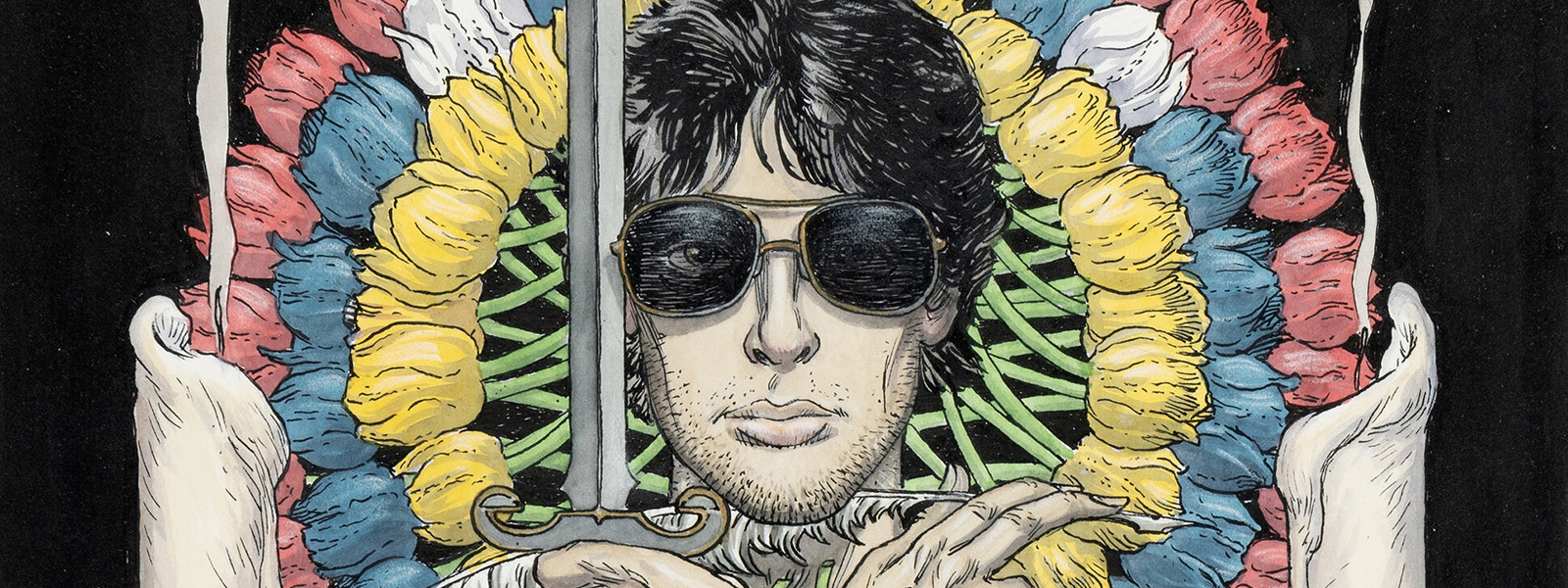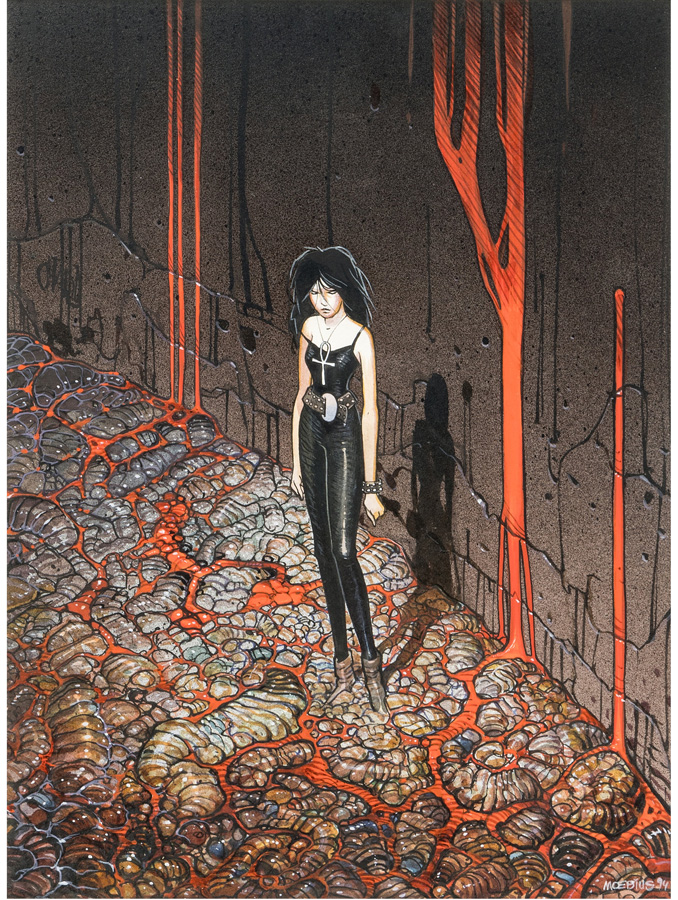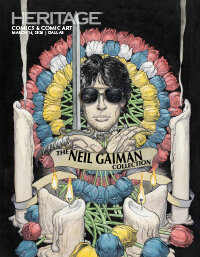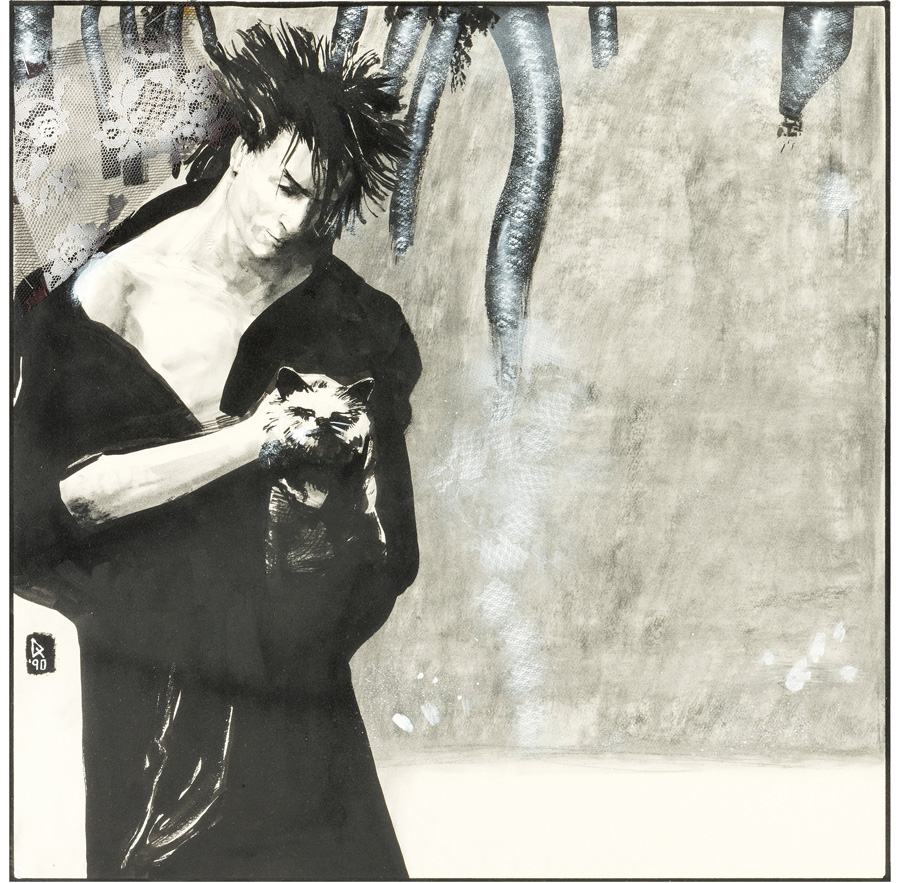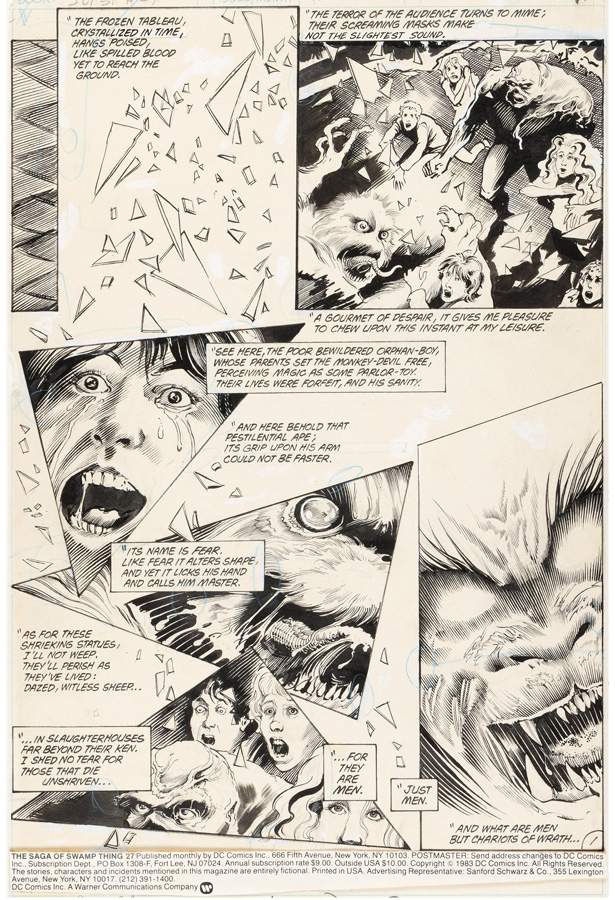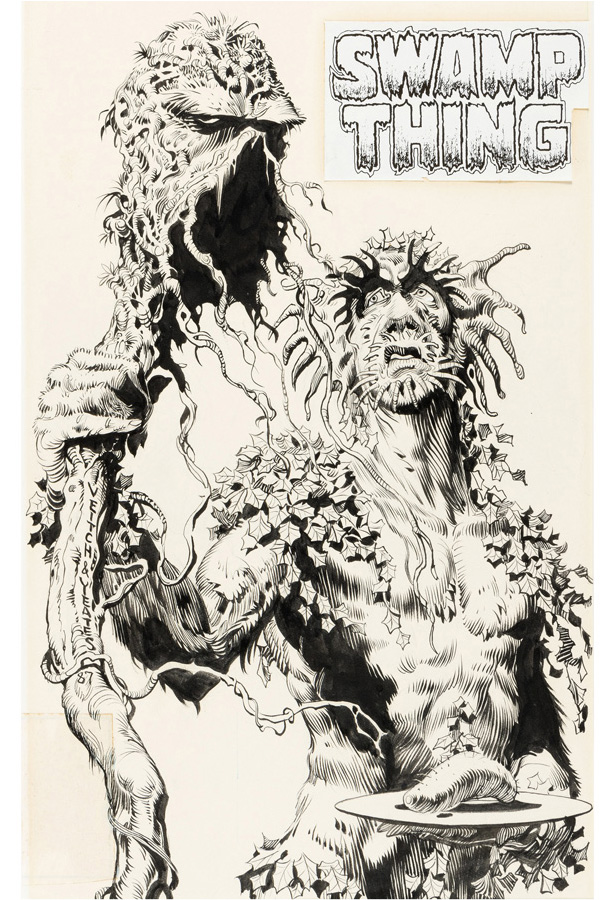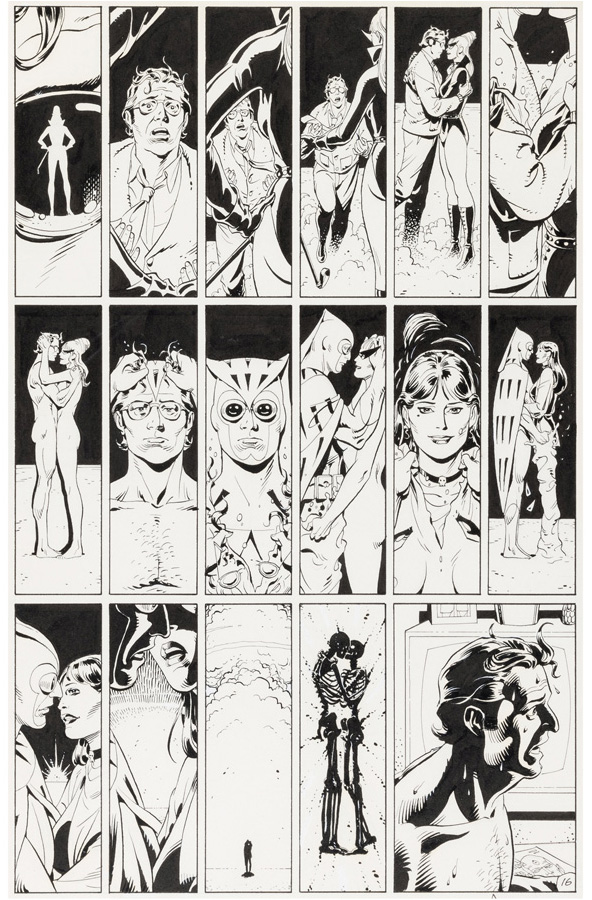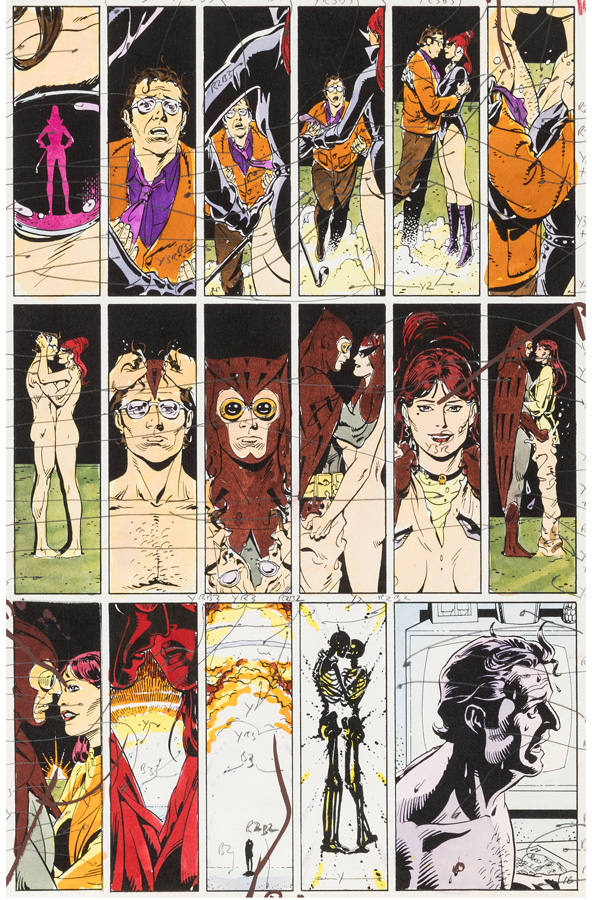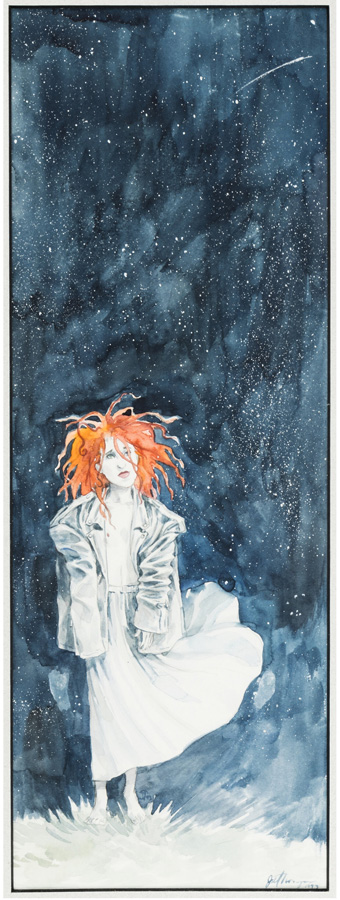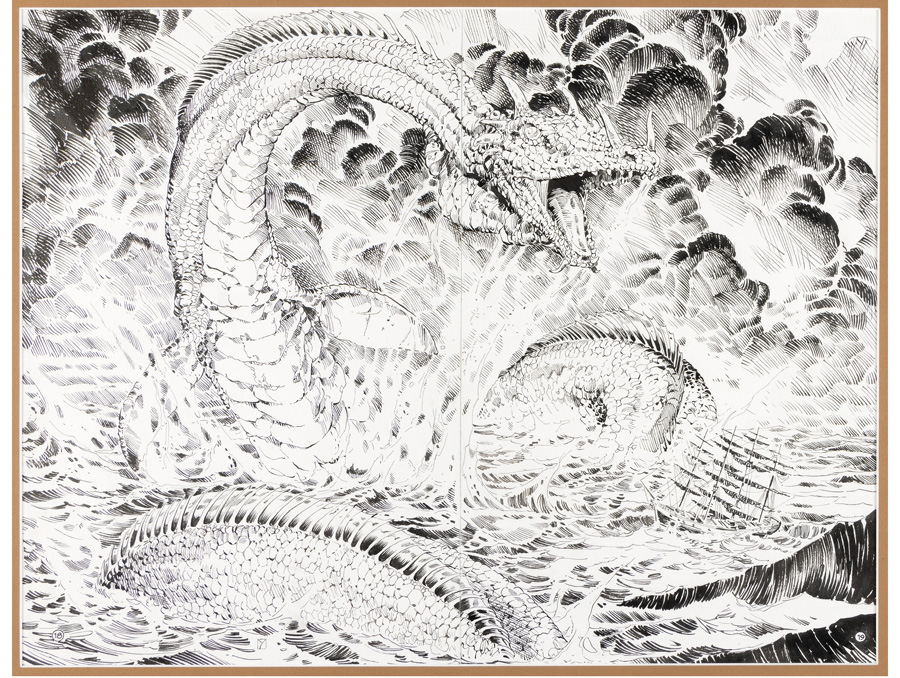THE ‘SANDMAN’ CREATOR ON WHY HE’S PARTING WITH SIGNED COMIC BOOKS, PRIZED MOEBIUS ARTWORK, LIMITED-EDITION COLLECTIBLES AND MUCH MORE
By Robert Wilonsky
Neil Gaiman is always telling a story, even when the creator of Sandman and bestselling author of such novels as American Gods, Good Omens and Coraline is auctioning some of his prized pieces. Look no further than Jean Giraud’s 1994 painting of Death of the Endless, sister of the titular Sandman whose epic tale spans the universe’s origin through the present day.
In this 1994 illustration, Jean Giraud, aka Moebius, adds his style to Neil Gaiman’s iconic character Death of the Endless.
The painting, rendered in bottomless blacks and carotid crimsons, is among the myriad centerpieces in Heritage’s Neil Gaiman Collection Comics & Comic Art Signature® Auction, which is open for bidding and culminates with a live auction on March 14 with Gaiman in attendance. It’s not just a famous artist’s painting of a beloved character; it is also a chapter in this auction’s rich narrative.
Numerous artists have illustrated Gaiman’s Sandman stories or depicted Dream and his siblings for promotions or pleasure. Many of their breakthrough pieces can be found in this event – those by Michael Zulli, Jill Thompson, Yoshitaka Amano, Gaiman’s Stardust collaborator Charles Vess and Mike Dringenberg, who Gaiman says was “utterly the quintessential Sandman artist in many ways.”
THE NEIL GAIMAN COLLECTION COMICS & COMIC ART SIGNATURE® AUCTION 7364
March 14, 2024
Online: HA.com/7364
INQUIRIES
Roberta Kramer
312.260.7222
RobertaK@HA.com
Most of the works in the auction were gifted to Gaiman, tokens of reverence and affection from the interpreter to the inspiration. But that Death by Giraud – better known as Moebius, the Franco-Belgian author and artist whose reach extends into every medium – is the only piece in the auction Gaiman purchased for himself. Simply because “I love that piece so much,” he says.
When he was 14 in 1974, Gaiman visited France with his classmates. There, the young man from England spied the first issue of the French comics anthology Métal hurlant, which Giraud co-founded, and bought a copy with all the money he had saved. Gaiman couldn’t understand French, but Moebius’ work, which looked like comic books from the future, needed no translator. Gaiman would later say that single issue made him want to create comics when he grew up.
“I actually wrote a story in Sandman: Endless Nights for Moebius to draw,” Gaiman says years later, “and he got back to me and said, ‘I don’t think I’m in good enough physical shape to draw this.’” A second hoped-for collaboration in 2002 also fell through due to Giraud’s declining health.
Gaiman saw the Giraud Death in a New York gallery and bought the small piece that cost almost as much as Gaiman was paid to write a single issue of Sandman.
“Since 1996, it has been hanging on my wall, and I walk past it, and it makes me smile every time I see it,” he says. “I love it so much. But there are so many Moebius fans out there – and so many people out there who love Death – and I think it would bring incredible joy to the world.”
This is but one story among the 126 lots in Gaiman’s auction, one that ties it all together – the moment the inspiration feted the inspired. From the original artwork to the signed comic books, the Coraline puppets used on-screen to the limited-edition sculptures, the handmade Christmas stories given as gifts to the awards he was given, everything in the auction was chosen by Gaiman to spread that joy and to spin another tale.
Morpheus illustration (1990) by Mike Dringenberg
“Yes, you are selling the artwork, the collectibles, but you’re also giving them the story,” Gaiman said recently from the London set of Sandman’s second season for Netflix. “Each of those pieces of art is, for me, a story. It’s a story of how I got it. It’s the story of what it meant to me. And I want to try and pass some of those stories on as well.”
A portion of the auction’s proceeds will benefit The Hero Initiative, which, since 2000, has been providing medical and monetary assistance to veteran comics creators, writers and artists in need of a helping hand. Some of the proceeds will also go to the Authors League Fund, which, since 1917, has helped professional authors, journalists, critics, poets and dramatists who find themselves in financial need because of medical or health-related problems, temporary loss of income or other misfortunes.
Gaiman will also share some of the proceeds with the artists who made his imagination tangible enough to put on Bristol board. And, as one might expect, there’s a story behind the auction, too: Gaiman was inspired by his friend Geoff Notkin, the star of TV’s Meteorite Men who played drums in Gaiman’s punk band when they were kids and started illustrating comics while Gaiman was still a young journalist. Notkin has held two auctions through Heritage, with a portion of those proceeds going toward causes dear to the Meteorite Man.
Gaiman asked Notkin why he was parting with his beloved treasures, among them rocks that had fallen from space. To which Notkin replied, These things have been making me happy for decades. Now it’s time for someone else to find pleasure in them. Gaiman was reluctant at first. But slowly, he came around to the idea that he was not meant to safeguard these things forever.
“I loved the idea of getting stuff that I’ve had for a long time out into the world,” he says.
Steve Bissette and John Totleben ‘Saga of the Swamp Thing’ No. 27 story page 1 original art (DC, 1984)
Rick Veitch and Tom Yeates ‘Swamp Thing’ No. 66 cover original art (DC, 1987)
The auction goes back to that moment when the grown-up Gaiman rekindled his love affair with comics in his early 20s: when he discovered Alan Moore’s take on DC’s horror staple Swamp Thing. Here, in the telling of Gaiman’s origin story, is a Steve Bissette and John Totleben page from 1984’s Saga of the Swamp Thing No. 27 that pays homage to Jack Kirby’s The Demon. There’s another by the same tandem from 1985’s Swamp Thing Annual No. 2 co-starring Deadman, who later came alive in several of Gaiman’s stories. There’s also the cover of Swamp Thing No. 66 by its writer, Rick Veitch, whom Gaiman nearly succeeded on the title.
“I’d loved Swamp Thing when I was a kid, and when I saw it years later on the newsagent at Victoria Station when I was 23, it took me months before I could pick one up,” Gaiman says. “I think I was resistant in the manner of somebody who knows that there is no getting slightly back into comics. If I let this thing back into my heart, I was lost. I was in love. It was everything I’d imagined you could do with the power of imagery in comics.”
That was in 1984, and within two years Alan Moore had taught Gaiman how to write comic-book scripts and asked him to assist with some research on a story he was writing, Watchmen. Moore also chose Gaiman as his successor on a book called Miracleman. Both were essentially comic books about readers’ relationships with superheroes and the medium.
As a thank-you, Moore and his illustrating partner Dave Gibbons gifted Gaiman the page from Watchmen where the Nite Owl awakens from a horrific dream in which he and Silk Spectre are lovers obliterated by a nuclear blast. Watchmen’s creators signed and inscribed the piece, the series’ lone 17-panel page, which is available in this auction along with John Higgins’ original color guide. Here, too, is a cover from Miracleman – Issue No. 16, the last issue written by Moore before Gaiman took the reins.
Dave Gibbons and John Higgins ‘Watchmen’ No. 7 story page 16 original art with matching production color guide (DC, 1987)
Some of Moore’s most significant DC work is here, as well: a page from the 1989 issue of Secret Origins in which he gave Poison Ivy the tragic origin story that continues to define Batman’s adversary. The page was drawn by Mark Buckingham, best known for creating the modern-day fairy tale Fables.
Some of the auction’s most intimate items may well prove among its most coveted: a signed limited printing of “A Writer’s Prayer,” an autographed unpublished American Gods short story gifted at Christmas to a fortunate few, his Christmas short story “Nicholas Was” created with longtime collaborator Dave McKean. Gaiman has also included Charles Addams’ 1956 Cosmopolitan illustration “Suburbia,” featuring the oddities next door.
There’s also an iconic portrait of Gaiman by Michael Kaluta that served as the cover of 1999’s Gods & Tulips, a benefit book for the Comic Book Legal Defense Fund containing three of Gaiman’s speeches, including “Good Comics And Why You Should Sell Them.”
Tori Amos as Delirium of the Endless (1993) by Jill Thompson
Gaiman knows that his story would be incomplete without his Sandman Morpheus, represented in this auction by 56 pieces that chronicle Dream’s evolution from idea into acclaimed literature into action figures and plush toys.
Gaiman had no idea how huge the series had become until it appeared in paperback form and started selling by the thousands – and even then, he believed it thrived only among a boisterous, affectionate cult. Yet the series spawned reverent praise: Norman Mailer wrote that it was a “comic strip for intellectuals, and it’s about time.” Tori Amos, whose songs often reference Gaiman, treated The Endless as though they exist in this world. “On bad days,” she wrote in the introduction to 1994’s collection Death: The High Cost of Living, “I talk to Death constantly.”
Amos, Gaiman’s dear friend, appears in this auction – rendered as Delirium in an ethereal mixed-media work by Jill Thompson, who began working on Sandman in 1991.
There are also several works by Death co-creator Mike Dringenberg, whose “Sandman really defined the look and the feel of the character,” Gaiman says. Among this significant lot is a mixed-media piece featuring Dream that has been seen only once – on a flyer announcing Gaiman’s signing at Night Flight Comics in Salt Lake City in 1990. Dringenberg also gifted Gaiman a mixed-media portrait of Death, done in 1992. The piece was originally a test for a Death graphic novel.
Here, too, is another Sandman rarity: one of the few double-page spreads from the series, in which Michael Zulli and Dick Giordano introduce the sea serpent.
“I was acutely conscious while writing Sandman that every panel counted,” Gaiman says. “I had 24 pages. If I was going to do a double-page spread, I needed a huge reason for it. There are almost none. There are a couple in ‘Season of Mists’ where I needed to show the vastness of hell and the gates, but one of them that I always looked forward to doing was the double-page spread of the sea serpent. I knew it had to be huge in order to work. And Michael Zulli gave me that sea serpent drawn by him and inked by the amazing Dick Giordano, who was a friend and a legend. And I thought, OK, that for me is one of those magical Sandman pieces.”
Michael Zulli and Dick Giordano ‘Sandman’ No. 53 double splash page 18-19 Sea Serpent original art (DC/Vertigo, 1993)
There is magic dust sprinkled throughout the auction for every fan of each of Gaiman’s works, including 2002’s Coraline, a terrifying “young adult” novel in which a young girl is abducted by mirror-universe versions of her mother and father, who want to keep, and perhaps eat, her. Gaiman had always envisioned his book as a film, and in 2009, animator Henry Selick made one of those beautiful rarities that parents love watching as much as their children.
From that film, Gaiman offers an on-screen, camera-used puppet of Coraline in her orange polka-dot pajamas accompanied by her ever-present companion, The Cat. Like everything else in the auction, Gaiman struggled with letting Coraline go. He did so only because the right reason had come at the right time.
“I’ve had her now for 15 years, and I look at her every day and go, ‘I love you. You’re beautiful,’” he says. “But I also am so aware that Coraline, the movie, has become this huge cultural phenomenon that has nothing to do with me in its own magical way. You’ve got generations of kids who have grown up on the movie. You’ve got adults who come over to me and explain that either I was responsible for their love of horror or I was responsible for decades of therapy, and Coraline is this thing. And I’m like, OK, you should go out and make these people incredibly happy.”
 ROBERT WILONSKY is a staff writer at Intelligent Collector.
ROBERT WILONSKY is a staff writer at Intelligent Collector.

